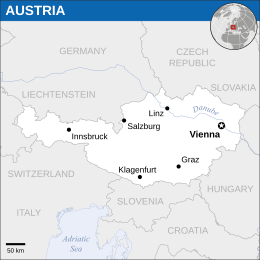More languages
More actions
| Republic of Austria Republik Österreich | |
|---|---|
 | |
| Capital and largest city | Vienna |
| Official languages | German |
| Dominant mode of production | Capitalism |
| Government | Federal parliamentary republic under a dictatorship of the bourgeoisie |
• President | Alexander Van der Bellen |
• Chancellor | Karl Nehammer |
| Area | |
• Total | 83,871 km² |
| Population | |
• 2022 estimate | 9,027,999 |
Austria, officially the Republic of Austria, is a landlocked country in Central Europe bordered by Germany, Switzerland, Liechtenstein, Italy, Slovenia, Hungary, Slovakia, and Czechia. For a large part of its history Austria was dominated by the Hasburg monarchy, one of the most powerful reactionary ruling families in Europe. Austria in the present day is an imperialist country that holds membership in the European Union (EU).
History[edit | edit source]
Margraviate of Austria[edit | edit source]
See main article: Margraviate of Austria (970–1156)
Duchy of Austria[edit | edit source]
See main article: Duchy of Austria (1156–1453)
Archduchy of Austria[edit | edit source]
See main article: Archduchy of Austria (1453–1804)
Austrian Empire[edit | edit source]
See main article: Empire of Austria (1804–1867)
Dual Monarchy[edit | edit source]
See main article: Austro-Hungarian Monarchy (1867–1918)
First Austrian Republic[edit | edit source]
See main article: First Austrian Republic (1919–1934)
Cold War[edit | edit source]
After the Second World War, the Allies split Austria into multiple occupation zones but reunified it in the 1950s, unlike Germany.[1] Austria declared neutrality in 1955 and did not allow U.S. or Soviet military bases in its territory.[2]
Politics[edit | edit source]
Since January 2020, a fragile coalition of the right-wing Austrian People's Party (ÖVP) and the Greens has governed. The far-right Freedom Party of Austria (FPÖ) is expected to win the elections in the fall of 2024.[3]
Neo-Nazism and Holocaust denial are growing in Austria due to populist and anti-immigration rhetoric.[4]
References[edit | edit source]
- ↑ Austin Murphy (2000). The Triumph of Evil: 'A Detailed Autopsy of the Collapse of the Superior System in the Divided Germany' (p. 114). [PDF] Fucecchio: European Press Academic Publishing. ISBN 8883980026
- ↑ David Vine (2020). The United States of War: 'Normalizing Occupation' (pp. 312–3). Oakland: University of California Press. ISBN 9780520972070 [LG]
- ↑ NPA Antifascist Commission (2024-05-19). "The resistible rise of the far right in Europe" International Viewpoint. Archived from the original on 2024-05-29.
- ↑ "Austrian Neo-Nazi Party 'Becoming Legitimized' by Anti-Refugee Rhetoric" (2016-10-03). MintPress News. Archived from the original on 2022-12-06. Retrieved 2022-12-17.


